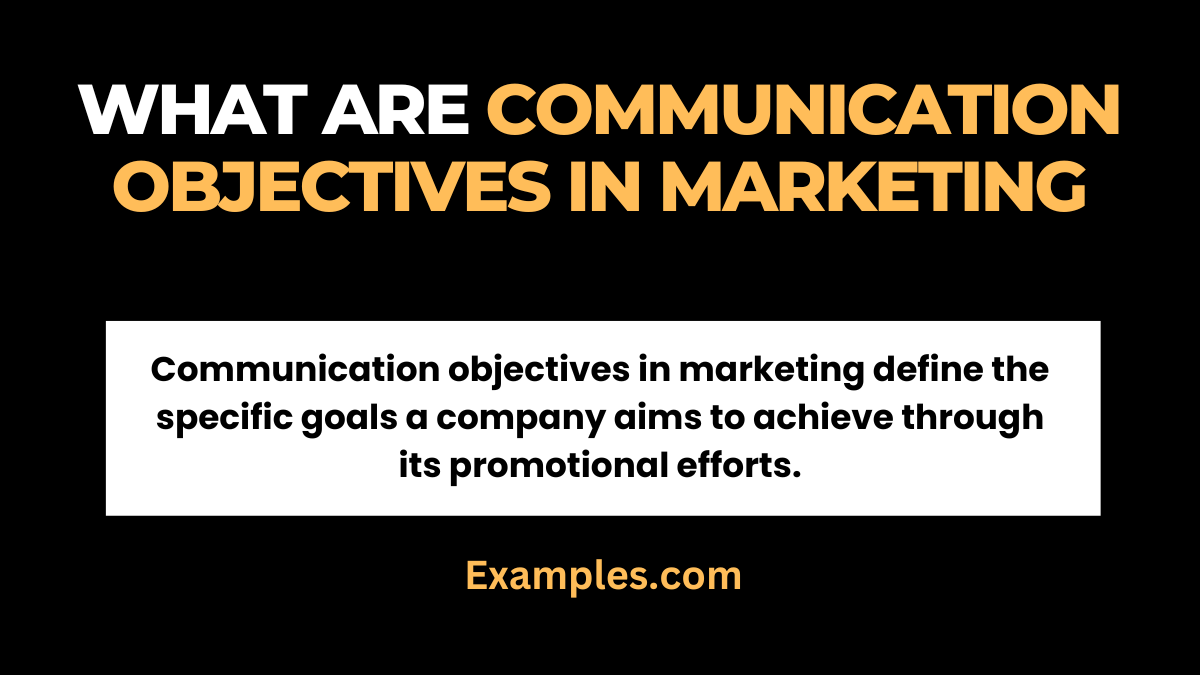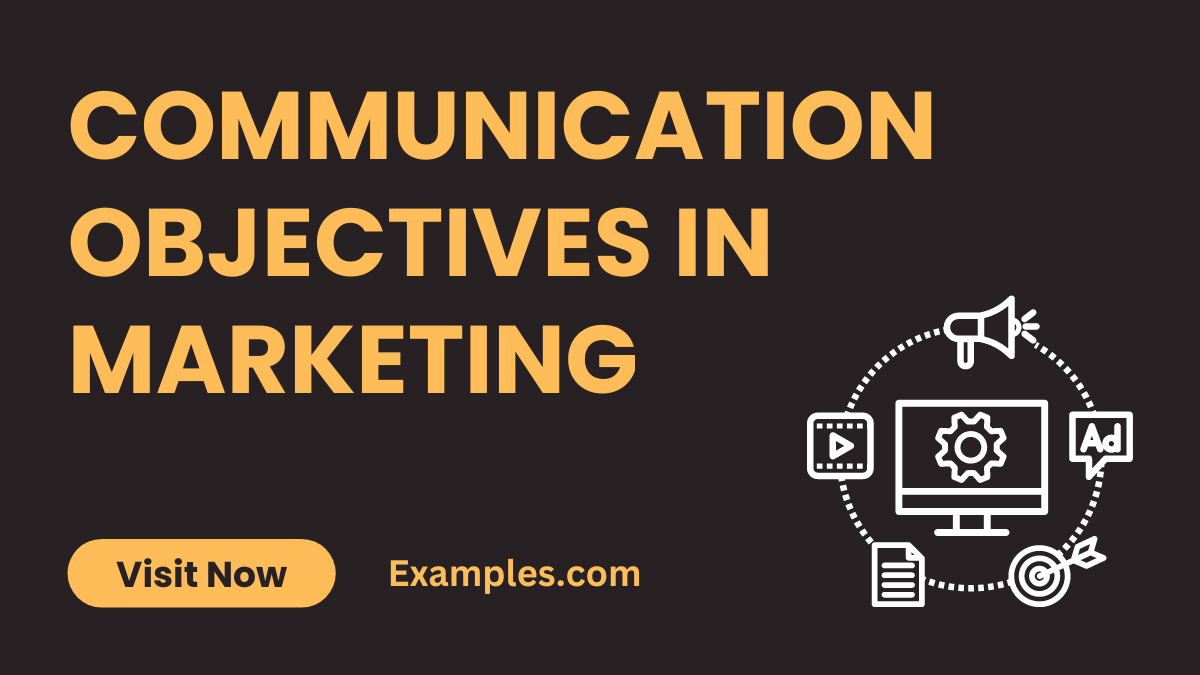14+ Communication Objectives in Marketing Examples
Embark on a transformative journey into the realm of marketing communication objectives. In this comprehensive guide, we unravel the intricacies of establishing effective communication goals in a company’s marketing strategy. From enhancing brand awareness to fostering customer engagement, we delve into real-world communication examples that illuminate the path to crafting impactful marketing campaigns. Join us in exploring the strategies that bridge the gap between brands and audiences, ensuring marketing communication becomes a catalyst for success.
What Are Communication Objectives In Marketing

Communication objectives in marketing define the specific goals a company aims to achieve through its promotional efforts. These objectives articulate the intended outcomes of communication strategies, whether it’s building brand awareness, driving sales, or fostering customer relationships. In simpler terms, they serve as a roadmap, outlining what a company wants to communicate and accomplish to effectively connect with its target audience and attain overall marketing success.
15 Communication Objectives In Marketing Examples
Explore the diverse landscape of marketing communication objectives with our guide. Uncover how these objectives drive successful campaigns, from creating brand resonance to enticing customer actions. Discover the art of crafting compelling messages that resonate with target audiences, setting the stage for marketing triumphs.

- Brand Awareness: Enhance brand recognition through consistent messaging across platforms.
Example: Boldly showcase your logo and tagline in every marketing material to imprint your brand on the audience’s mind. - Customer Engagement: Foster interactive relationships with the audience.
Example: Use polls on social media to encourage customer participation and feedback, creating a two-way communication channel. - Lead Generation: Capture potential customer information for future engagement.
Example: Offer downloadable resources on your website in exchange for visitors’ email addresses, building a valuable lead database. - Sales Conversion: Drive prospects toward making a purchase.
Example: Implement clear and compelling calls-to-action in marketing materials, guiding potential customers seamlessly through the purchasing journey. - Product Education: Communicate the benefits and features of products.
Example: Create informative video tutorials showcasing product functionalities, aiding customers in understanding product utility. - Customer Retention: Strengthen relationships with existing customers.
Example: Send personalized thank-you emails or exclusive offers to loyal customers, reinforcing their connection with the brand. - Market Expansion: Reach new demographics and markets.
Example: Adapt marketing messages to resonate with diverse audiences, ensuring inclusivity and broadening market reach. - Competitor Differentiation: Highlight unique selling points against competitors.
Example: Emphasize exclusive features or benefits that set your product apart in comparison with competitors. - Social Responsibility Messaging: Align marketing with social causes.
Example: Communicate the brand’s commitment to sustainability through eco-friendly packaging and ethical sourcing. - Crisis Management: Develop communication strategies for unforeseen challenges.
Example: Address negative feedback promptly, showcasing transparency and commitment to resolving issues. - Influencer Partnerships: Leverage influencers for brand promotion.
Example: Collaborate with influencers whose values align with the brand, creating authentic endorsements that resonate with their followers. - Event Promotion: Drive attendance and engagement for events.
Example: Utilize social media teasers, email campaigns, and visually appealing graphics to create buzz around upcoming events. - Customer Feedback Collection: Encourage customer opinions for improvement.
Example: Implement online surveys or feedback forms, demonstrating a commitment to understanding and meeting customer needs. - Cross-Selling: Promote complementary products to existing customers.
Example: Bundle related products in promotions, enticing customers to explore additional offerings. - Employee Advocacy: Mobilize employees as brand ambassadors.
Example: Encourage employees to share company achievements on social media, leveraging their networks for organic brand promotion.
Communication Objectives in Marketing at a Company
Dive into the tailored communication objectives within a company’s marketing framework. This guide explores the nuanced goals and strategies that companies employ to amplify their brand, engage audiences, and ultimately drive marketing success through effective communication strategies.
- Internal Alignment: Foster harmony among internal teams for unified messaging.
Example: Boldly articulate company goals and values to ensure all departments align their communication strategies. - Stakeholder Collaboration: Establish communication channels with key stakeholders.
Example: In monthly newsletters, communicate company updates, fostering transparency and engagement with investors and partners. - Brand Consistency: Ensure uniform brand messaging across all platforms.
Example: Maintain consistent brand colours, fonts, and tone in all marketing materials for a cohesive brand identity. - Market Research Integration: Infuse customer insights into communication strategies.
Example: Boldly incorporate customer feedback in marketing messages to address specific needs and preferences. - Data-Driven Decision Making: Leverage analytics for refining communication strategies.
Example: Analyse customer engagement metrics to tailor communication efforts for maximum impact and resonance.
What are the Basic Objectives of All Marketing Communication Methods?
In the intricate web of marketing communication, understanding the fundamental objectives is paramount. This comprehensive guide dissects the core goals that underpin all communication methods, providing a roadmap for crafting effective strategies that resonate with audiences and drive marketing success.
- Conveying Clear Messages: Successful marketing communication methods aim to deliver messages that are concise, compelling, and easily understood. Clarity ensures that the intended information reaches the audience without ambiguity.
- Building Brand Awareness: Irrespective of the method used, fostering brand recognition is a universal objective. Effective communication should imprint the brand in the audience’s memory, creating a lasting and positive impression.
- Establishing Credibility: All communication methods strive to build trust. Establishing credibility through transparent and authentic messaging is fundamental to gaining the confidence of the target audience.
- Engaging Target Audiences: Effective communication methods actively engage the intended audience. Whether through compelling visuals, interactive content, or personalized messaging, engagement is key to capturing attention and maintaining interest.
- Encouraging Desired Actions: Every communication method aims to drive specific actions. Whether it’s making a purchase, signing up for a newsletter, or participating in a campaign, effective communication motivates the audience to take desired steps.
- Adapting to Diverse Platforms: The digital era demands adaptability. Marketing communication methods must optimize messages for various platforms, ensuring a seamless and consistent brand experience across channels.
- Responding to Customer Feedback: Two-way communication is vital. Marketing methods should create avenues for customer feedback, allowing brands to respond promptly and demonstrate a commitment to customer satisfaction.
In conclusion, this guide navigates the intricate landscape of communication objectives in marketing, offering a comprehensive understanding of core principles. From fostering brand resonance to driving engagement and embracing diverse platforms, the key lies in a strategic and adaptable approach. Armed with real-world examples, this guide serves as a valuable resource, empowering marketers to craft compelling strategies that resonate and thrive in the dynamic realm of marketing communication.



